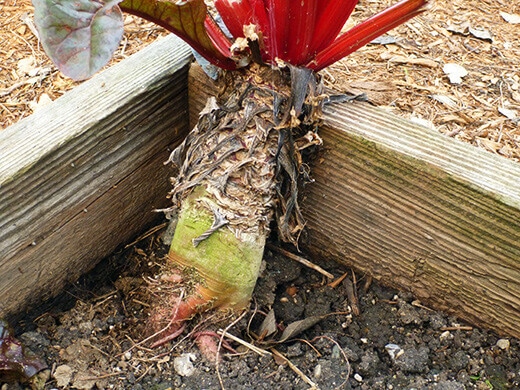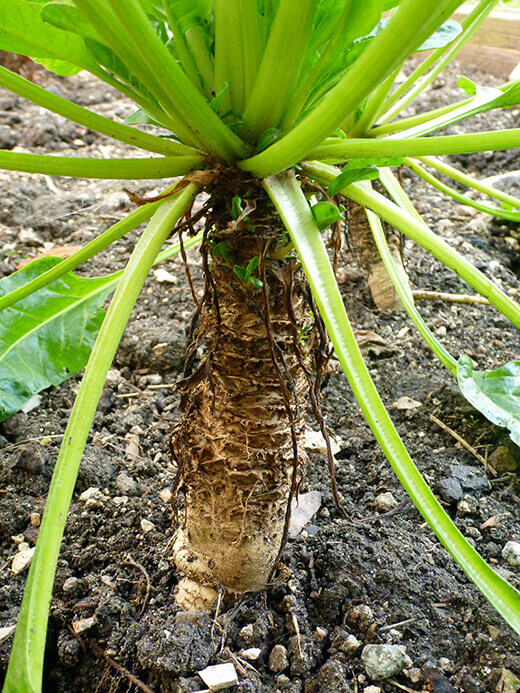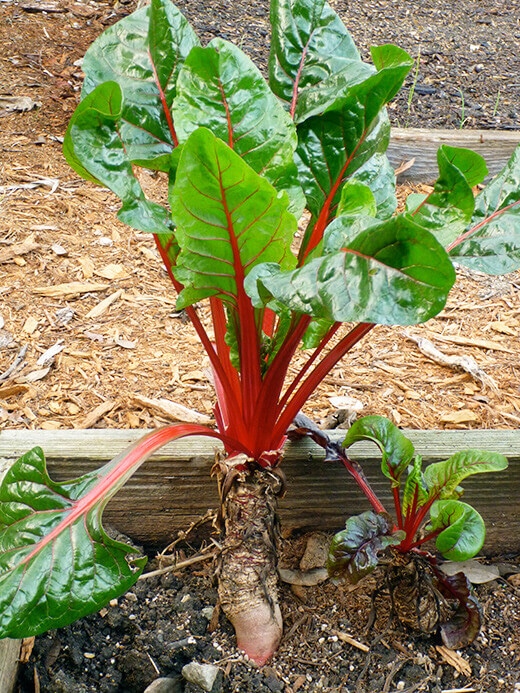I have a raised bed in my garden that barely gets any sun in the winter. Whatever’s growing there in the summer usually stays there until spring, when the days are longer and I plant anew.
Being a bienniel, that means my chard is the last of the crops to linger after the rest of the plants have bolted or died. It continues to grow delicious new leaves and sometimes even sends out new shoots (looking like little tree trunks), while the main “trunk” gets larger and woodier and pushed out of the ground.

Have you ever looked at the root of a second-year chard and thought… hmm that looks familiar?
Chard (Beta vulgaris) is also known as leaf beet or spinach beet, and in fact the two share the same botanical name, though chard is specifically Beta vulgaris v. cicla. The common beet is cultivated for its fleshy root, while chard is cultivated for its foliage.
So what came first, the beet or the chard?
Turns out, chard has been in existence since at least the 4th century BC — pretty much since the first written records of food were established in Europe. It was known as the sea beet (Beta vulgaris v. maritima), or wild beet, originating in the Mediterranean and spreading eastward into the area we now call the Middle East. (It still grows wild in these regions, and its leaves are so palatable that it’s known locally as wild spinach — thus our given names of spinach beet and perpetual spinach for those leafy greens.)
The beets that we see today were unknown before the Christian era, though it was believed that the ancients used the roots of the sea beet for medicinal purposes. Over several centuries, the sea beet (harvested primarily for its leaves) evolved into a multi-purpose plant as epicureans from the Roman Empire started cooking with the swollen roots that were harvested selectively from sea beets.
There would be no public record of beets again until 14th-century England, which revealed recipes using the root exclusively. It was still a rarity in the 16th century, when German records described a red beet with a turnip-like root. Though the beet remained an unimportant food crop through the next few hundred years, cultivation continued and picked up more popularity when it was brought to the United States in the early 19th century.
Most modern beets were only introduced to home gardens within the last 150 years, and they now come in a rainbow of colors from dark purple to snow white (and my personal favorite, Chioggia, which features pink and white-striped flesh) and in a spectrum of shapes from spherical to cylindrical. The garden beet is specifically bred for its sweet and earthy root, sending all of its energy into developing the root its first year.
Meanwhile, the cicla variety of Beta vulgaris (what we commonly call chard) sends all of its energy into developing a full head of foliage in its first year. Both varieties are bienniels, though a chard root will begin to swell (looking like a beetroot) at the end of its second year after it’s produced all of its leaves.

So in theory, chard root is edible (meaning it won’t kill you) as it belongs to the same species as the beet. But since the plant doesn’t start developing its root until the end of its life, the chard root is a hard, fibrous and bitter trunk, rather than the tender, fleshy and earthy root that we harvest from beet plants. (Have you ever left a radish in the ground too long? Such tough little suckers they become!)
Of course, if anyone out there actually wants to test this theory and roast up a chard root, please send me a report on your edible experiment!
















I found some Wild Swiss Chard in a yard of a house that will be demolished. I recognized it as an edible vegetable. Googled some Swiss Chard Recipes, and made Swiss Chard Pesto, which called for Ramps (a Green, but pink onion that some say can be poisonous) I used Garlic instead, along with Parmesan Cheese, Almond Slivers, and Olive Oil. It came out great, but was bitter, and almost feel light headed from it, as though it made me gave me a buzz. Don’t feel ill, plant was very fiberous, which makes my stomach growl. I read on the internet how Swiss Chard is very healthy for people, especially with diabetes. I will now buy it from the store on a regular basis, after I run out of the pesto I froze for later use.
Swiss chard root is awesome when grown for eating. It needs to be grown in light fluffy compost and the leaves not harvested. The part above ground and below the stem is the best part. Harvest after a few light frost for the best sweetness. I cut them in 1/2 inch cubes and boil until tender about 45 mins. Season with salt and pepper and mash with butter and greek yogurt. Evergreen herbs and dill seeds are also good in them
Good to know, thanks for sharing!
Hi. My husband discovered the bulb as he. was cleaning up the row. I peeled. Chopped up and roasted. They are very sweet and if you cook long enough. They turn tenderish. But they are very nummy
Our son accidentally pulled out one of our first year chards. The root was about the size of a baby beet. So I sautéed the root with the leaves & stems with some olive oil, onion and lemon pepper & sprinkled some goat cheese. It was a hit & a great Mother’s Day treat. The first year root was tender and very similar to a beet root, but a bit milder.
Very good to know!
I bought an oriental radish mix. Planted it. New types of radishes , great … then what I thought was spinach tops , had tasty little large radish size, beet flavored bulbs on bottom… What is this vegetable? I got to get more… A new type of Swiss Chard?
What does your seed packet say? It should list the varieties in the mix.
Oct 21, 2013 – I was helping Phyllis clean out her organic market garden today (near Penticton, British Columbia – arid climate) and she was chopping up the chard leaves (red) to till into the soil for next year and putting aside the tough roots for disposal in the “fibrous” pile for long term composting . . . so I decided to take a few of these roots home and see if I could eat them. They were stubby carrot shaped with large feeder roots and some hairy roots particularly towards the bottom of the main root which was about 5″ long and 2″ diameter at the top. I tried some of the root raw and when I compared it to the flavour of a raw round red beet from her garden I felt the chard root was a little sweeter with a similar earthy flavour. They both were crunchy and edible but the chard was a little woodier. However I think this is an unfair comparison because the Chard was older having been harvested (leaves) for at least 2 months on a weekly basis whereas the beet was small and young (& tender!!) I cooked the chard root for about 25 minutes in about 1″ of water covered. The chard root lost some of its red colouring (which alternated with white rings) so that it was mostly just a pale reddish colour. I had removed the upper part of the “neck” where the leaves were forming and some of the “hair” and the longer feeder roots. It cooked easily. The skin was thin like a winter storage beet but slipped off easily just like a beet skin. Of course with all the little hairy bits and more bumps than a smooth beet, I had to use my paring knife to clean it up a bit before I bit in . . . tasted just like a beet! Surprise, surprise! I would say that in a blind test a person could not tell the difference. The neck was fibrous and there were some outer fibrous rings near the top. I cut the neck off after cooking but when I tasted it there was no real difference with the root – just fibrous which for old guys like me is probably a good thing! FYI! I would definitely consider this vegetable root as a beet substitute and it would probably be great in a stew (or Borscht) without the red beet colour dominating the mixed vegetables. Have fun experimenting guys!
I can report that the root of Rainbow chard is delicious roasted. We had an entire bed of rainbow chard ..the plants being about one year old.. that we cleared out . I wondered if the root was edible and sliced some and tried it raw. It had a slight peppery sweet and nutty flavour raw. Everyone who tried it thought it was pretty good.
We roasted 5 of the bigger roots with a leg of lamb that night. When baked the flavour of our roots became much nuttier and sweeter… imagine caramel and roasted peanuts ! If the raw root snaps when bent it will have good eating texture. We have now decided to keep growing more chard to roast the roots.
Good to know!
I have usually been using the leaves in my cooking until I mistook some freshly picked, rather small Chard for white carrots. I cut and sauteed them with onion and it tasted really nice with rice! I didn’t really think anything of it until someone told me that it was actually Chard Root! They also told me that it was unhealthy to eat the root itself (thus my research which found this page). Apparently there’s no ill effects that I’ve noticed. I’d eat it again so long as I find nothing to the contrary.
If you picked your chard root while it was fairly young, I don’t see why you couldn’t eat it!
That’s a shame, chard is one of my favorite leafy greens in the garden! It’s the perfect soup/stew green in my opinion.
This season I’ll be growing tomatoes, peppers, eggplants, amaranth, lettuce, mizuna, more chard, corn, squash, beans, melons… the list goes on. I just started more onions and leeks last week. Spring and summer are my busiest time of year!
Jun Iguchi liked this on Facebook.
Yeah, I use extension a lot too. Science-based.
Thanks Carol! I used several sources including the TX and NC cooperative extensions.
Luann Watson liked this on Facebook.
Kitchen Garden Maui liked this on Facebook.
Excellent article….just wondering , as a fellow garden writer , what were your sources?
Elisa Arif liked this on Facebook.
I doubt it would be any good. I throw them out. I haven’t grown swiss chard in years now, as Hubby is anit-chard….and I have just gotten him to accept spring beets…but not his favorite.
What will you be growing this year??
Nancy
wildoakdesigns.blogspot.com
Cristyane Lamastra-Conner liked this on Facebook.
Aagaard Farms liked this on Facebook.
Kelly Dugan Guerin liked this on Facebook.